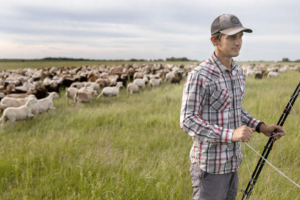5:50
News Story
Farming among the trees: How perennial crops can help breathe life into depleted soil
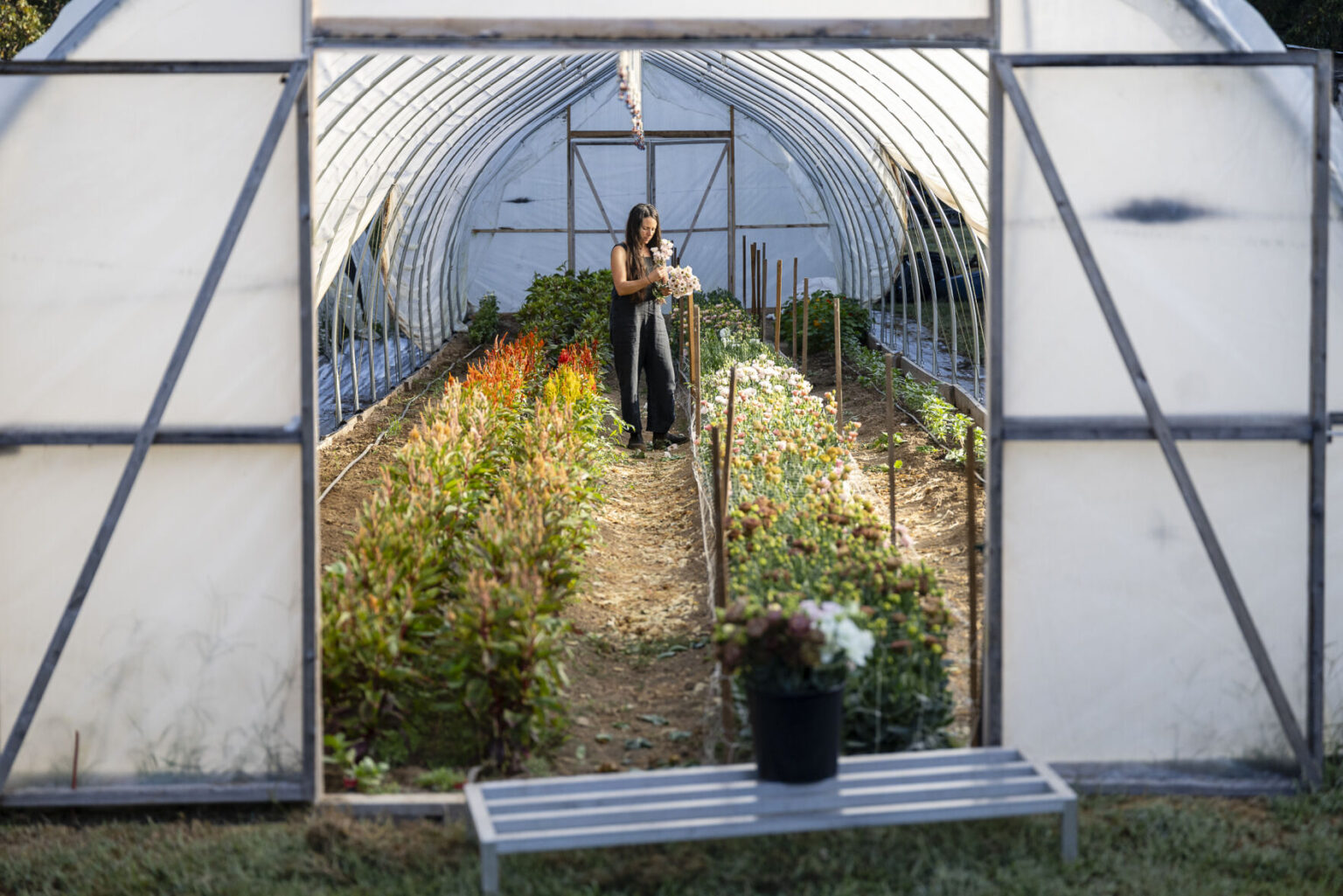
Emily Wright picks flowers growing safely in a garden tunnel Sept. 17 at Three Creeks Farm and Forest in Ashland. Wright saves the tunnels for high value crops such as these flowers, tomatoes and peppers, which are watered through drip irrigation and micro overhead sprinklers. (Cory W. MacNeil/Columbia Missourian)
On harvest days at Three Creeks Farm and Forest in the Missouri River valley, farm owner Emily Wright and her staff collect three varieties of leafy greens from the field.
“We can’t really grow enough,” she said. “We try to have consistent supply throughout the course of our season — which is basically April to December — but it’s hard to keep up.”
Two staff members cut the lettuce close to the root, fan the leaves across their hands checking for bugs or wilts, and toss them in a bright orange basket. From there the greens are washed, packed and driven to town for delivery at local restaurants and grocery stores.
Wright co-owns and manages the farm with her partner Paul Weber, who moonlights as a touring musician. They have been growing fruits, vegetables, herbs and flowers for nine seasons in a diversified market garden style farm in the Missouri River hills. Additionally, two thirds of their 15-acre farm is a forest.
“I think of it as sort of my long-term outdoor ecological experiment,” she said.
Wright and Weber plant perennials such as fiddlehead ferns and wild leeks throughout the forest. They also grow native trees including paw paws along the forest edge, allowing them to cross pollinate with and be protected by the more mature trees.
Wright calls the smorgasbord of vegetables, fruits, shrubs and trees on Three Creeks Farm and Forest “complex and chaotic” and said the crops benefit by growing among each other.
“I feel like I’ve witnessed an explosion of biodiversity in the past couple of years,” Wright said. “I mostly see it in insect populations, but I also feel like I’ve noticed new bird species and lots more amphibians and reptiles and just generally a lot of life in this valley.”
Operating a farm within its natural ecosystem is a tenet of regenerative agriculture — a movement that aims to revive farmland soils and by extension diverse farms and rural communities.
With climate change threatening farmland and the farm economy, people are looking to regenerative agriculture as a new way forward, specifically using perennial crops that don’t require the intensive annual tillage, planting, fertilizing and harvesting of conventional commodities.
Tim Crews is the chief scientist at The Land Institute in Salina, Kansas, and said many of the commodity crops we eat — corn, rice, barley, oats — are annual.
“Annuals require the termination of all vegetation on the landscape for them to have a chance,” he said. “If you do that on massive landscapes year after year after year, you get soil degradation.”
The Land Institute scientists have been working on sustainable agriculture research and education across the Midwest and Great Plains for decades. They’re developing perennial grains that aren’t as hard on the environment as annuals. Crews said row crops take an environmental toll over time.
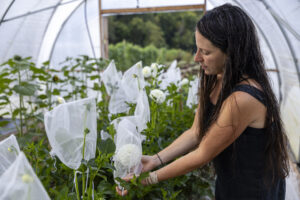
“They have no capacity to retain nutrients. Their microbial communities are much less functional than those that exist in mature grasslands or forests,” Crews said. “It’s such a compromised ecosystem.”
But if more perennial crops existed, he said, they could break the food system’s dependency on annual crops and transform farms into something more akin to a natural ecosystem, like a forest.
Regenerative agriculture aims to, in part through perennials, breathe life into depleted soils while also reducing the need for chemical fertilizers and pesticides, which can have negative environmental consequences.
“The regenerative capacity of perennials is kind of unmatched … there’s economic advantages, there’s lifestyle advantages, there’s wildlife advantages,” Crews said.
Combining farm and forest
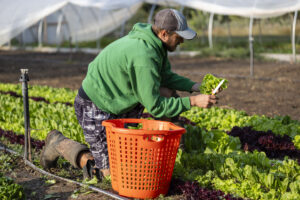
There is much to be harvested from trees and shrubs, like nuts or berries, and there are many soil health and ecosystem benefits of having them on the farm.
“Agroforestry is basically offering kind of a toolkit for being able to incorporate some of that ecological design onto a landscape,” said Zack Miller, preserve engagement manager with The Nature Conservancy in Missouri.
The organization is conducting ecosystem restorations across the state. Miller is coordinating a 164-acre agroforestry demonstration project at the Missouri River Center — the former site of riverfront bar and restaurant Katfish Katy’s.
The long-term goal of the project is to both connect people to the Missouri River and its ecosystems and to serve as a living agroforestry laboratory to “demonstrate what these systems could look like and be able to demonstrate their economic returns, how farmers might be able to implement different strategies,” Miller said.
Trees, shrubs and perennials can be integrated sporadically into conventional farms through alley cropping, prairie strips, wind breaks, hedge rows and more. But for agroforestry to be successful, Miller said we’ll have to get used to a messier kind of farm.
“Looking across landscapes and seeing how we have it divvied up and this chunk is for growing this one plant, this chunk is for growing something else,” he said. “But of course, ecosystems don’t function that way. There are no clear borders.”
Three Creeks Farm and Forest intentionally planted perennials with culinary or floral purposes that allow them to sell berries, nuts and fresh cut flowers to groceries and restaurants. Wright also planted a row of smokebush, a perennial shrub, with a dual purpose as a windbreak — blocking dust that gets kicked up from their gravel road.
Wright said she sees plenty of opportunity across the Midwest for conventional row crop farms to incorporate more diverse products in their operations.
“Just carving off those odd little corners that don’t fit the giant industrial tractors and … converting those to vegetable production would have a huge impact on the amount of food that’s being supplied locally,” she said.
Miller said that due to the amount of inputs required — fertilizer, fuel and equipment — the row crop commodity farming that made Midwestern agriculture so bountiful is no longer working.
Biodiversity has plummeted, and so has the ability to make a living in agriculture, Miller said.
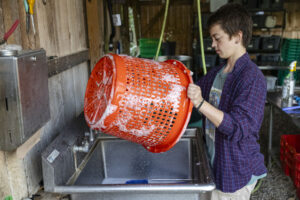
“It’s like very simple to say, but the answer to many of our problems is diversity,” he said.
Wright understands how some farmers, due to the pressures of policy and markets, get stuck in a rigid structure.
“There’s not a lot of room for experimentation or adaptation,” she said.
But by operating a small, diverse operation like Three Creeks Farm and Forest, experimentation and adaptation never stops. Wright and Weber recently added fermentation business to the farm, which allows them to offer sauerkraut, pickles and okra to local restaurants.
“One of the reasons that farming is really attractive and engaging for me is just the learning curve never drops off,” Wright said. “It’s like, as soon as we get the hang of things and it gets even the tiniest bit boring, we add something.”
Diversification has not only helped Wright’s farm environmentally, but also economically.
“We don’t really qualify for crop insurance programs so diversification is kind of our insurance, because we do have crop failures every year,” she said.
“We kind of just accept that while one thing might go awry, another thing is going to be flourishing, and that both maintains our livelihood, but also maintains morale.”
This article has been republished from the Columbia Missourian. Read the original article here.
GET THE MORNING HEADLINES.
Our stories may be republished online or in print under Creative Commons license CC BY-NC-ND 4.0. We ask that you edit only for style or to shorten, provide proper attribution and link to our website. AP and Getty images may not be republished. Please see our republishing guidelines for use of any other photos and graphics.




